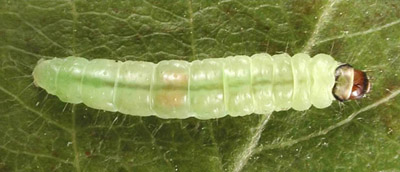California Agricultural Technology Institute
Research team explores biological control of orchard pest
Researchers from Fresno State and the University of California have been exploring
new methods of controlling an insect pest of California’s growing pistachio industry.
Professor Andrew Lawson of Fresno State’s Department of Plant Science led the study
to learn more of the life-cycle traits of a tiny parasite that may provide control
of obliquebanded leafroller (OBLR), which damages California pistachios.
 “OBLR causes economic damage to a variety of nut, fruit and ornamental plants, including
pistachio, almond, apple, blueberry, cherry, peach, pear, filberts and raspberry,”
Lawson said. “Although once considered a secondary pest in pistachio, in recent years
OBLR has become a pest of primary concern. In some infested orchards, population densities
have been observed at such high levels that extensive defoliation and crop damage
resulted.”
“OBLR causes economic damage to a variety of nut, fruit and ornamental plants, including
pistachio, almond, apple, blueberry, cherry, peach, pear, filberts and raspberry,”
Lawson said. “Although once considered a secondary pest in pistachio, in recent years
OBLR has become a pest of primary concern. In some infested orchards, population densities
have been observed at such high levels that extensive defoliation and crop damage
resulted.”
In a series of laboratory tests, Lawson’s research team, which included Fresno State students, studied B. cushmani life traits including longevity, eggs per female, periods of egg deposition, and developmental time from egg to adult.
In a search for biological control of OBLR, Lawson joined with UC Cooperative Extension researchers Kent Daane and Glenn Yokota to learn if a smaller parasitoid insect called Bracon cushmani could decrease populations of OBLR. The parasitoid feeds on OBLR larvae.
“These life history traits allow us to determine the potential impact this parasitoid could have on controlling its host [OBLR] populations,” Lawson said.
Additional project work included releases of the parasitoid in pistachio orchards to determine its spread. Although results were not conclusive, they did demonstrate promise in the use of B. cushmani as an augmentative biological control agent.
In another phase of the study, methods for rearing the parasitoid in the laboratory were refined, including design of rearing chambers.
“This will inform future efforts to mass rear the parasitoid in a commercial insectary,” Lawson said. For additional study results, contact him at alawson@csufresno.edu
Partial funding for this research was provided by the California State University Agricultural Research Institute (ARI), with additional support from the California Pistachio Commission and the University of California Integrated Pest Management Program.